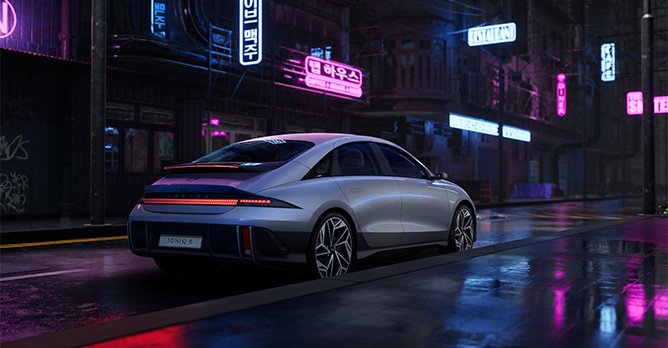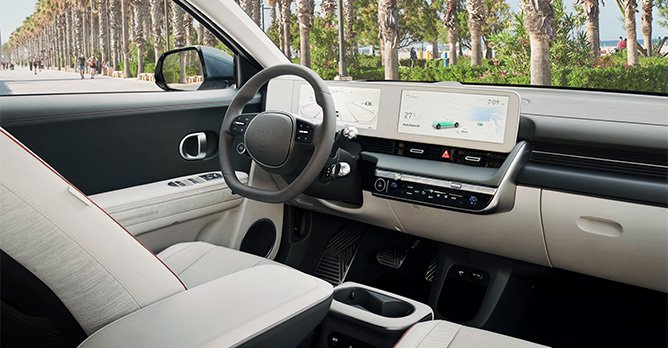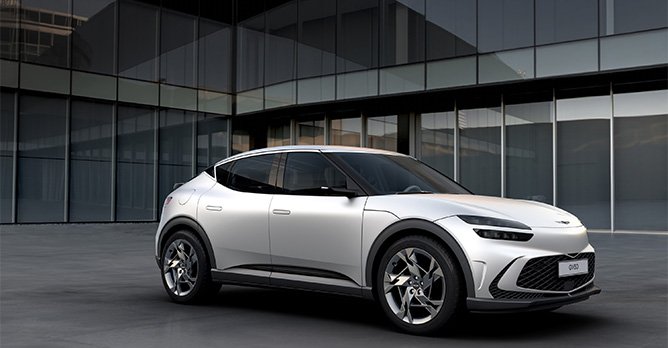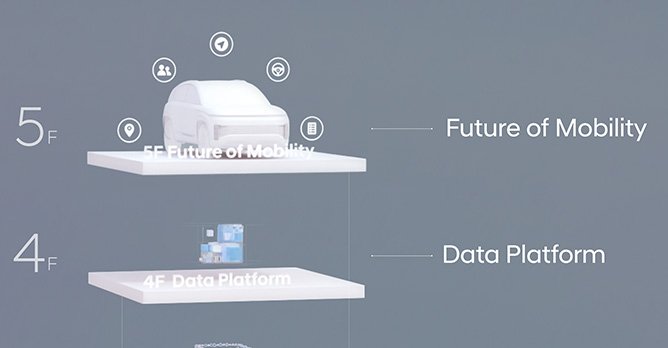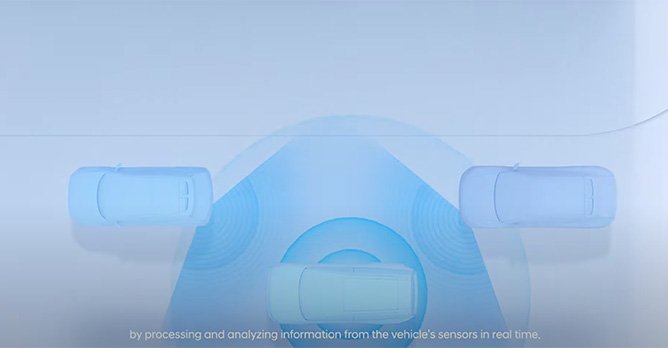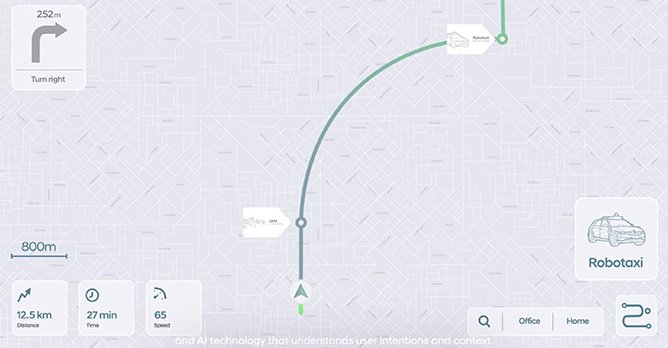A look at Hyundai Motor Group's massive new era of 'software-defined vehicles' by 2025
13 Oct 2022|3,079 views
"A tectonic shift to a new age of mobility is dawning", declares Hyundai Motor Group (HMG) at the end of its global forum presentation - named Unlock the Software Age - unveiling a grand roadmap for the future of the company.
But you wouldn't have needed Korea's largest auto conglomerate to tell you that the vehicles (not just cars) of tomorrow will be simultaneously marked by cleaner drivetrains and by their ability to remotely and reflexively renew themselves in response to a transport landscape constantly in flux.
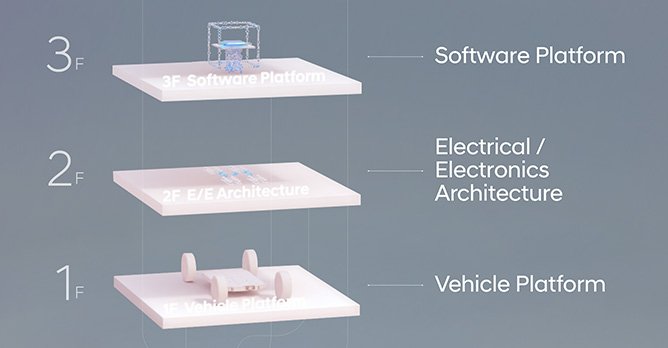
 Floors One to Three of the Software House: Vehicle Platform, Electrical/Electronics Architecture, and Software Platform The question was always about who would lead the switch, and with its new plan, HMG is demonstrating that it wants to be on the knife's edge of it. To do this, it's got a progressive 'Five-Floor Software House' (a multi-tiered strategy) to illustrate how - and with what it's introduced as Software-Defined Vehicles (SDVs), too, the first full iterations of which we can expect from the firm by 2025. (Watch as 'SDVs' become the new buzz-term of the next decade).
Floors One to Three of the Software House: Vehicle Platform, Electrical/Electronics Architecture, and Software Platform The question was always about who would lead the switch, and with its new plan, HMG is demonstrating that it wants to be on the knife's edge of it. To do this, it's got a progressive 'Five-Floor Software House' (a multi-tiered strategy) to illustrate how - and with what it's introduced as Software-Defined Vehicles (SDVs), too, the first full iterations of which we can expect from the firm by 2025. (Watch as 'SDVs' become the new buzz-term of the next decade).
From over-the-air (OTA) updates, to self-driving cars and proprietary operating systems, here's what stood out to us as we sat in on the forum:
First floor: Vehicle Platform (a.k.a. Even more modularity across Hyundai, Genesis and Kia)
In line with the new age of SDVs, Hyundais, Genesises and Kias will soon all be built on two new platform types, housed under the group's new Integrated Modular Architecture (IMA) system. These will be introduced in 2025, and notably, appear to be different from the still-fresh E-Global Modular Platform (E-GMP) underpinning cars like the Hyundai Ioniq 5 and Ioniq 6, and Kia EV6.
The first, called 'eM', is said to be a passenger EV-dedicated platform that can cut across different segments and body types. On the other hand, the 'eS' platform will be applied to what HMG is calling 'Purpose-Built Vehicles' (PBVs), which will include (but not be exclusive to) commercial vehicles.
The goal is to modularise and standardise EV components, such as batteries and motors, across these two platforms. As for what benefits will be reaped, HMG believes that developmental complexity of its vehicles will be lowered at the same time that their technical reliability is raised.
The big headline, however, is that all vehicle segments housed under these two platforms will be equipped to receive over-the-air updates from 2025, although passenger cars (including ICE cars as well) will benefit even earlier - from 2023. Approximately 40 markets worldwide, including the U.S.A., Europe, China and India, are apparently already ready for this.
Simultaneously, 'Features on Demand' (the latest trend in the market we haven't quite made our minds up about) will soon also apply to the Group's vehicles as a result.
Nonetheless, when asked if essential features will become chargeable (the question specifically targeted heated seats), executives stressed that the overarching goal is to provide customers with more choice - they can opt out of features they don't deem to have value - and that research is ongoing in preparation for the actual rollout. A subscription for ventilated seats, anyone?
Second floor: Electrical / Electronics Architecture (a.k.a. Better-rounded vehicles)
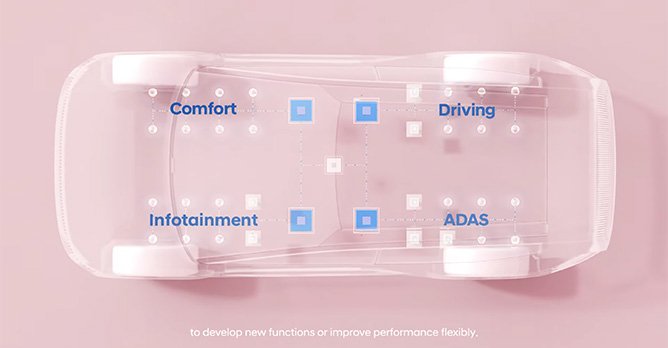
 While continuing their focus on the four domains, the third-gen controllers will be more powerful and integrate multiple domains together Even if we leave the 'golden' goal of autonomous driving out of the picture briefly, cars are capable of performing much more today than they could a mere 10 years ago. For that, we have powerful controllers to thank, which help to simultaneously manage and maintain the efficient, rapid, and smooth functioning of multiple components at once.
While continuing their focus on the four domains, the third-gen controllers will be more powerful and integrate multiple domains together Even if we leave the 'golden' goal of autonomous driving out of the picture briefly, cars are capable of performing much more today than they could a mere 10 years ago. For that, we have powerful controllers to thank, which help to simultaneously manage and maintain the efficient, rapid, and smooth functioning of multiple components at once.
With its controllers, HMG's roadmap for its SDV-centred future will focus on four main domains - comfort, driving, Advanced Driving Assistance Systems (ADAS) and infotainment - with the goal of even integrating two domains together in single controllers along the way.
Even as more functions get introduced to the vehicles it produces, the group believes this outlined 'Domain Centralised Architecture' will maintain a good level of flexibility in delivering updates and responding to its users' needs.
The controllers are currently already in their second generation, and Hyundai says that the third-generation, to be rolled out too around 2025, will be 10 times more powerful. Most crucially, the Group says that these will debut Level 3 Autonomous Driving capabilities in its cars while laying vital pipelines for Level 4 and 5.
Third floor: Software Platform (a.k.a. Hyundai OS)
To power the aforementioned controllers, a proprietary operating system has also been developed by HMG to be progressively applied to its vehicles.
The large umbrella is called the 'controlled car Operating System' (or ccOS) that will not only "perform computations at blazing speed", but also have a standardised architecture that can be shared with each controller.
The ccOS is further split into three types. ccOS.e (for 'embedded') primarily manages driving performance and comfort in combination; ccOS.a (for 'ADAS') does the heavy-lifting work of ensuring the car's safety; while ccOS.i is largely responsible for the car’s infotainment.
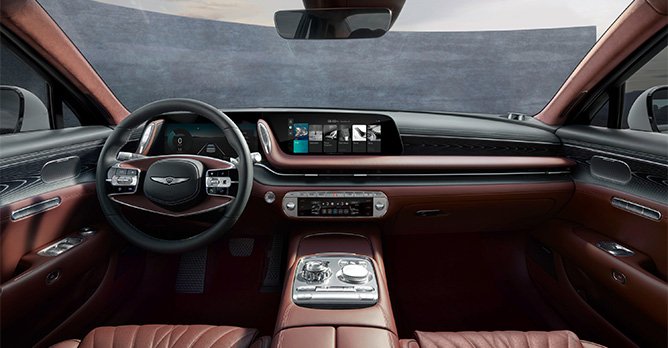
 The driver's cluster, infotainment, and head-up display are run off the ccIC in the GV60 and G90 (pictured) An example of a real-life example based off the ccOS.i is the ccIC (connected car Integrated Cockpit) used in Genesis' GV60 SUV and G90 sedan. Running off a single hardware-software combination, the Integrated Cockpit combines the driver's cluster, infotainment system and head-up display.
The driver's cluster, infotainment, and head-up display are run off the ccIC in the GV60 and G90 (pictured) An example of a real-life example based off the ccOS.i is the ccIC (connected car Integrated Cockpit) used in Genesis' GV60 SUV and G90 sedan. Running off a single hardware-software combination, the Integrated Cockpit combines the driver's cluster, infotainment system and head-up display.
To this end, HMG will also continue its partnership with NVIDIA (a name you might have already seen working with other manufacturers) for its high-performance information processing semiconductors, to ensure that the hardware in its vehicles can also sustain the sheer processing power needed to run the software.
Fourth floor: Data Platform (a.k.a. Big data)
A vast amount of data is amassed throughout the life cycle of your car, all the way from its manufacturing start, to the inevitable point when you decide it’s time to move on and make a switch.
The use phase, too, will only continue to become more data-intensive as vehicles constantly breach new levels of technological sophistication. For something already rooted in the present, just consider the example of ADAS, which is processing and understanding data in real-time from the car's cameras, sensors and radars, and at lightning speed.
Close to 20 million vehicles from HMG will be hooked up virtually to its connected services by 2025. It's estimated that these vehicles will have produced two exabytes of data by that point.
To rein in these diverse, never-ending streams of information, HMG says it has built a data management architecture (described as 'support beams for a building'), firstly by standardising the manner in which all this data is expressed and understood.
As with other precious raw materials, unearthing data and understanding it is only the first step; collection and refinement have to follow after. Whatever data is collected by HMG will flow through a distributed storage and processing platform, built across pre-determined and curated domains.
Two key terms are of note here - 'flexible' and 'policy-based' - suggesting the Group is keenly aware that your Kia or Hyundai functions will vary based on where you're driving it and… how you want to drive it. Drill down even deeper into these Data Hubs, and you'll find what HMG is calling a 'tiering technology', which will process data according to different levels of importance.
In literal concrete terms, HMG is also establishing a Global Software Centre as it prepares to enter the 'mobility and logistics market'. Up to 18 trillion won (more than S$18 billion) will go into the Centre and R&D headquarters by 2030.
Fifth floor: Future of Mobility (a.k.a. the SDV embodied, and embedded in the larger context)
It's worth noting that Hyundai chose the President of its TaaS Division - 'Transport as a Service' - to present the fifth and final floor of the Software House. (Also, it's worth noting that Hyundai has a TaaS division.)
With everything thus far building towards the Software-Defined Vehicle, expect not just technologically-advanced cars from Hyundai, but commercial vehicles, robots and robotaxis, and even Advanced Air Mobility.
Here, the ultimate goal of HMG's Software Age is revealed: It wants to control the entire end-to-end journey for everyone on the move - including the sizable group that doesn't want to own cars or drive them - and integrate its SDVs with the smart, AI-powered services we access from our personal devices.
In case everything thus far hasn't really made much sense, just remember this: The Five-Floor Software House is Hyundai's full-out, all guns blazing mobility offensive that shows its doesn't want to just be one of the world's biggest carmakers; its eyes are trained further, on entire transport landscapes.
But you wouldn't have needed Korea's largest auto conglomerate to tell you that the vehicles (not just cars) of tomorrow will be simultaneously marked by cleaner drivetrains and by their ability to remotely and reflexively renew themselves in response to a transport landscape constantly in flux.

From over-the-air (OTA) updates, to self-driving cars and proprietary operating systems, here's what stood out to us as we sat in on the forum:
First floor: Vehicle Platform (a.k.a. Even more modularity across Hyundai, Genesis and Kia)
In line with the new age of SDVs, Hyundais, Genesises and Kias will soon all be built on two new platform types, housed under the group's new Integrated Modular Architecture (IMA) system. These will be introduced in 2025, and notably, appear to be different from the still-fresh E-Global Modular Platform (E-GMP) underpinning cars like the Hyundai Ioniq 5 and Ioniq 6, and Kia EV6.
The first, called 'eM', is said to be a passenger EV-dedicated platform that can cut across different segments and body types. On the other hand, the 'eS' platform will be applied to what HMG is calling 'Purpose-Built Vehicles' (PBVs), which will include (but not be exclusive to) commercial vehicles.
The goal is to modularise and standardise EV components, such as batteries and motors, across these two platforms. As for what benefits will be reaped, HMG believes that developmental complexity of its vehicles will be lowered at the same time that their technical reliability is raised.
The big headline, however, is that all vehicle segments housed under these two platforms will be equipped to receive over-the-air updates from 2025, although passenger cars (including ICE cars as well) will benefit even earlier - from 2023. Approximately 40 markets worldwide, including the U.S.A., Europe, China and India, are apparently already ready for this.
Simultaneously, 'Features on Demand' (the latest trend in the market we haven't quite made our minds up about) will soon also apply to the Group's vehicles as a result.
Nonetheless, when asked if essential features will become chargeable (the question specifically targeted heated seats), executives stressed that the overarching goal is to provide customers with more choice - they can opt out of features they don't deem to have value - and that research is ongoing in preparation for the actual rollout. A subscription for ventilated seats, anyone?
Second floor: Electrical / Electronics Architecture (a.k.a. Better-rounded vehicles)

With its controllers, HMG's roadmap for its SDV-centred future will focus on four main domains - comfort, driving, Advanced Driving Assistance Systems (ADAS) and infotainment - with the goal of even integrating two domains together in single controllers along the way.
Even as more functions get introduced to the vehicles it produces, the group believes this outlined 'Domain Centralised Architecture' will maintain a good level of flexibility in delivering updates and responding to its users' needs.
The controllers are currently already in their second generation, and Hyundai says that the third-generation, to be rolled out too around 2025, will be 10 times more powerful. Most crucially, the Group says that these will debut Level 3 Autonomous Driving capabilities in its cars while laying vital pipelines for Level 4 and 5.
Third floor: Software Platform (a.k.a. Hyundai OS)
To power the aforementioned controllers, a proprietary operating system has also been developed by HMG to be progressively applied to its vehicles.
The large umbrella is called the 'controlled car Operating System' (or ccOS) that will not only "perform computations at blazing speed", but also have a standardised architecture that can be shared with each controller.
The ccOS is further split into three types. ccOS.e (for 'embedded') primarily manages driving performance and comfort in combination; ccOS.a (for 'ADAS') does the heavy-lifting work of ensuring the car's safety; while ccOS.i is largely responsible for the car’s infotainment.

To this end, HMG will also continue its partnership with NVIDIA (a name you might have already seen working with other manufacturers) for its high-performance information processing semiconductors, to ensure that the hardware in its vehicles can also sustain the sheer processing power needed to run the software.
Fourth floor: Data Platform (a.k.a. Big data)
A vast amount of data is amassed throughout the life cycle of your car, all the way from its manufacturing start, to the inevitable point when you decide it’s time to move on and make a switch.
The use phase, too, will only continue to become more data-intensive as vehicles constantly breach new levels of technological sophistication. For something already rooted in the present, just consider the example of ADAS, which is processing and understanding data in real-time from the car's cameras, sensors and radars, and at lightning speed.
Close to 20 million vehicles from HMG will be hooked up virtually to its connected services by 2025. It's estimated that these vehicles will have produced two exabytes of data by that point.
To rein in these diverse, never-ending streams of information, HMG says it has built a data management architecture (described as 'support beams for a building'), firstly by standardising the manner in which all this data is expressed and understood.
As with other precious raw materials, unearthing data and understanding it is only the first step; collection and refinement have to follow after. Whatever data is collected by HMG will flow through a distributed storage and processing platform, built across pre-determined and curated domains.
Two key terms are of note here - 'flexible' and 'policy-based' - suggesting the Group is keenly aware that your Kia or Hyundai functions will vary based on where you're driving it and… how you want to drive it. Drill down even deeper into these Data Hubs, and you'll find what HMG is calling a 'tiering technology', which will process data according to different levels of importance.
In literal concrete terms, HMG is also establishing a Global Software Centre as it prepares to enter the 'mobility and logistics market'. Up to 18 trillion won (more than S$18 billion) will go into the Centre and R&D headquarters by 2030.
Fifth floor: Future of Mobility (a.k.a. the SDV embodied, and embedded in the larger context)
It's worth noting that Hyundai chose the President of its TaaS Division - 'Transport as a Service' - to present the fifth and final floor of the Software House. (Also, it's worth noting that Hyundai has a TaaS division.)
With everything thus far building towards the Software-Defined Vehicle, expect not just technologically-advanced cars from Hyundai, but commercial vehicles, robots and robotaxis, and even Advanced Air Mobility.
Here, the ultimate goal of HMG's Software Age is revealed: It wants to control the entire end-to-end journey for everyone on the move - including the sizable group that doesn't want to own cars or drive them - and integrate its SDVs with the smart, AI-powered services we access from our personal devices.
In case everything thus far hasn't really made much sense, just remember this: The Five-Floor Software House is Hyundai's full-out, all guns blazing mobility offensive that shows its doesn't want to just be one of the world's biggest carmakers; its eyes are trained further, on entire transport landscapes.
"A tectonic shift to a new age of mobility is dawning", declares Hyundai Motor Group (HMG) at the end of its global forum presentation - named Unlock the Software Age - unveiling a grand roadmap for the future of the company.
But you wouldn't have needed Korea's largest auto conglomerate to tell you that the vehicles (not just cars) of tomorrow will be simultaneously marked by cleaner drivetrains and by their ability to remotely and reflexively renew themselves in response to a transport landscape constantly in flux.

 Floors One to Three of the Software House: Vehicle Platform, Electrical/Electronics Architecture, and Software Platform The question was always about who would lead the switch, and with its new plan, HMG is demonstrating that it wants to be on the knife's edge of it. To do this, it's got a progressive 'Five-Floor Software House' (a multi-tiered strategy) to illustrate how - and with what it's introduced as Software-Defined Vehicles (SDVs), too, the first full iterations of which we can expect from the firm by 2025. (Watch as 'SDVs' become the new buzz-term of the next decade).
Floors One to Three of the Software House: Vehicle Platform, Electrical/Electronics Architecture, and Software Platform The question was always about who would lead the switch, and with its new plan, HMG is demonstrating that it wants to be on the knife's edge of it. To do this, it's got a progressive 'Five-Floor Software House' (a multi-tiered strategy) to illustrate how - and with what it's introduced as Software-Defined Vehicles (SDVs), too, the first full iterations of which we can expect from the firm by 2025. (Watch as 'SDVs' become the new buzz-term of the next decade).
From over-the-air (OTA) updates, to self-driving cars and proprietary operating systems, here's what stood out to us as we sat in on the forum:
First floor: Vehicle Platform (a.k.a. Even more modularity across Hyundai, Genesis and Kia)
In line with the new age of SDVs, Hyundais, Genesises and Kias will soon all be built on two new platform types, housed under the group's new Integrated Modular Architecture (IMA) system. These will be introduced in 2025, and notably, appear to be different from the still-fresh E-Global Modular Platform (E-GMP) underpinning cars like the Hyundai Ioniq 5 and Ioniq 6, and Kia EV6.
The first, called 'eM', is said to be a passenger EV-dedicated platform that can cut across different segments and body types. On the other hand, the 'eS' platform will be applied to what HMG is calling 'Purpose-Built Vehicles' (PBVs), which will include (but not be exclusive to) commercial vehicles.
The goal is to modularise and standardise EV components, such as batteries and motors, across these two platforms. As for what benefits will be reaped, HMG believes that developmental complexity of its vehicles will be lowered at the same time that their technical reliability is raised.
The big headline, however, is that all vehicle segments housed under these two platforms will be equipped to receive over-the-air updates from 2025, although passenger cars (including ICE cars as well) will benefit even earlier - from 2023. Approximately 40 markets worldwide, including the U.S.A., Europe, China and India, are apparently already ready for this.
Simultaneously, 'Features on Demand' (the latest trend in the market we haven't quite made our minds up about) will soon also apply to the Group's vehicles as a result.
Nonetheless, when asked if essential features will become chargeable (the question specifically targeted heated seats), executives stressed that the overarching goal is to provide customers with more choice - they can opt out of features they don't deem to have value - and that research is ongoing in preparation for the actual rollout. A subscription for ventilated seats, anyone?
Second floor: Electrical / Electronics Architecture (a.k.a. Better-rounded vehicles)

 While continuing their focus on the four domains, the third-gen controllers will be more powerful and integrate multiple domains together Even if we leave the 'golden' goal of autonomous driving out of the picture briefly, cars are capable of performing much more today than they could a mere 10 years ago. For that, we have powerful controllers to thank, which help to simultaneously manage and maintain the efficient, rapid, and smooth functioning of multiple components at once.
While continuing their focus on the four domains, the third-gen controllers will be more powerful and integrate multiple domains together Even if we leave the 'golden' goal of autonomous driving out of the picture briefly, cars are capable of performing much more today than they could a mere 10 years ago. For that, we have powerful controllers to thank, which help to simultaneously manage and maintain the efficient, rapid, and smooth functioning of multiple components at once.
With its controllers, HMG's roadmap for its SDV-centred future will focus on four main domains - comfort, driving, Advanced Driving Assistance Systems (ADAS) and infotainment - with the goal of even integrating two domains together in single controllers along the way.
Even as more functions get introduced to the vehicles it produces, the group believes this outlined 'Domain Centralised Architecture' will maintain a good level of flexibility in delivering updates and responding to its users' needs.
The controllers are currently already in their second generation, and Hyundai says that the third-generation, to be rolled out too around 2025, will be 10 times more powerful. Most crucially, the Group says that these will debut Level 3 Autonomous Driving capabilities in its cars while laying vital pipelines for Level 4 and 5.
Third floor: Software Platform (a.k.a. Hyundai OS)
To power the aforementioned controllers, a proprietary operating system has also been developed by HMG to be progressively applied to its vehicles.
The large umbrella is called the 'controlled car Operating System' (or ccOS) that will not only "perform computations at blazing speed", but also have a standardised architecture that can be shared with each controller.
The ccOS is further split into three types. ccOS.e (for 'embedded') primarily manages driving performance and comfort in combination; ccOS.a (for 'ADAS') does the heavy-lifting work of ensuring the car's safety; while ccOS.i is largely responsible for the car’s infotainment.

 The driver's cluster, infotainment, and head-up display are run off the ccIC in the GV60 and G90 (pictured) An example of a real-life example based off the ccOS.i is the ccIC (connected car Integrated Cockpit) used in Genesis' GV60 SUV and G90 sedan. Running off a single hardware-software combination, the Integrated Cockpit combines the driver's cluster, infotainment system and head-up display.
The driver's cluster, infotainment, and head-up display are run off the ccIC in the GV60 and G90 (pictured) An example of a real-life example based off the ccOS.i is the ccIC (connected car Integrated Cockpit) used in Genesis' GV60 SUV and G90 sedan. Running off a single hardware-software combination, the Integrated Cockpit combines the driver's cluster, infotainment system and head-up display.
To this end, HMG will also continue its partnership with NVIDIA (a name you might have already seen working with other manufacturers) for its high-performance information processing semiconductors, to ensure that the hardware in its vehicles can also sustain the sheer processing power needed to run the software.
Fourth floor: Data Platform (a.k.a. Big data)
A vast amount of data is amassed throughout the life cycle of your car, all the way from its manufacturing start, to the inevitable point when you decide it’s time to move on and make a switch.
The use phase, too, will only continue to become more data-intensive as vehicles constantly breach new levels of technological sophistication. For something already rooted in the present, just consider the example of ADAS, which is processing and understanding data in real-time from the car's cameras, sensors and radars, and at lightning speed.
Close to 20 million vehicles from HMG will be hooked up virtually to its connected services by 2025. It's estimated that these vehicles will have produced two exabytes of data by that point.
To rein in these diverse, never-ending streams of information, HMG says it has built a data management architecture (described as 'support beams for a building'), firstly by standardising the manner in which all this data is expressed and understood.
As with other precious raw materials, unearthing data and understanding it is only the first step; collection and refinement have to follow after. Whatever data is collected by HMG will flow through a distributed storage and processing platform, built across pre-determined and curated domains.
Two key terms are of note here - 'flexible' and 'policy-based' - suggesting the Group is keenly aware that your Kia or Hyundai functions will vary based on where you're driving it and… how you want to drive it. Drill down even deeper into these Data Hubs, and you'll find what HMG is calling a 'tiering technology', which will process data according to different levels of importance.
In literal concrete terms, HMG is also establishing a Global Software Centre as it prepares to enter the 'mobility and logistics market'. Up to 18 trillion won (more than S$18 billion) will go into the Centre and R&D headquarters by 2030.
Fifth floor: Future of Mobility (a.k.a. the SDV embodied, and embedded in the larger context)
It's worth noting that Hyundai chose the President of its TaaS Division - 'Transport as a Service' - to present the fifth and final floor of the Software House. (Also, it's worth noting that Hyundai has a TaaS division.)
With everything thus far building towards the Software-Defined Vehicle, expect not just technologically-advanced cars from Hyundai, but commercial vehicles, robots and robotaxis, and even Advanced Air Mobility.
Here, the ultimate goal of HMG's Software Age is revealed: It wants to control the entire end-to-end journey for everyone on the move - including the sizable group that doesn't want to own cars or drive them - and integrate its SDVs with the smart, AI-powered services we access from our personal devices.
In case everything thus far hasn't really made much sense, just remember this: The Five-Floor Software House is Hyundai's full-out, all guns blazing mobility offensive that shows its doesn't want to just be one of the world's biggest carmakers; its eyes are trained further, on entire transport landscapes.
But you wouldn't have needed Korea's largest auto conglomerate to tell you that the vehicles (not just cars) of tomorrow will be simultaneously marked by cleaner drivetrains and by their ability to remotely and reflexively renew themselves in response to a transport landscape constantly in flux.

From over-the-air (OTA) updates, to self-driving cars and proprietary operating systems, here's what stood out to us as we sat in on the forum:
First floor: Vehicle Platform (a.k.a. Even more modularity across Hyundai, Genesis and Kia)
In line with the new age of SDVs, Hyundais, Genesises and Kias will soon all be built on two new platform types, housed under the group's new Integrated Modular Architecture (IMA) system. These will be introduced in 2025, and notably, appear to be different from the still-fresh E-Global Modular Platform (E-GMP) underpinning cars like the Hyundai Ioniq 5 and Ioniq 6, and Kia EV6.
The first, called 'eM', is said to be a passenger EV-dedicated platform that can cut across different segments and body types. On the other hand, the 'eS' platform will be applied to what HMG is calling 'Purpose-Built Vehicles' (PBVs), which will include (but not be exclusive to) commercial vehicles.
The goal is to modularise and standardise EV components, such as batteries and motors, across these two platforms. As for what benefits will be reaped, HMG believes that developmental complexity of its vehicles will be lowered at the same time that their technical reliability is raised.
The big headline, however, is that all vehicle segments housed under these two platforms will be equipped to receive over-the-air updates from 2025, although passenger cars (including ICE cars as well) will benefit even earlier - from 2023. Approximately 40 markets worldwide, including the U.S.A., Europe, China and India, are apparently already ready for this.
Simultaneously, 'Features on Demand' (the latest trend in the market we haven't quite made our minds up about) will soon also apply to the Group's vehicles as a result.
Nonetheless, when asked if essential features will become chargeable (the question specifically targeted heated seats), executives stressed that the overarching goal is to provide customers with more choice - they can opt out of features they don't deem to have value - and that research is ongoing in preparation for the actual rollout. A subscription for ventilated seats, anyone?
Second floor: Electrical / Electronics Architecture (a.k.a. Better-rounded vehicles)

With its controllers, HMG's roadmap for its SDV-centred future will focus on four main domains - comfort, driving, Advanced Driving Assistance Systems (ADAS) and infotainment - with the goal of even integrating two domains together in single controllers along the way.
Even as more functions get introduced to the vehicles it produces, the group believes this outlined 'Domain Centralised Architecture' will maintain a good level of flexibility in delivering updates and responding to its users' needs.
The controllers are currently already in their second generation, and Hyundai says that the third-generation, to be rolled out too around 2025, will be 10 times more powerful. Most crucially, the Group says that these will debut Level 3 Autonomous Driving capabilities in its cars while laying vital pipelines for Level 4 and 5.
Third floor: Software Platform (a.k.a. Hyundai OS)
To power the aforementioned controllers, a proprietary operating system has also been developed by HMG to be progressively applied to its vehicles.
The large umbrella is called the 'controlled car Operating System' (or ccOS) that will not only "perform computations at blazing speed", but also have a standardised architecture that can be shared with each controller.
The ccOS is further split into three types. ccOS.e (for 'embedded') primarily manages driving performance and comfort in combination; ccOS.a (for 'ADAS') does the heavy-lifting work of ensuring the car's safety; while ccOS.i is largely responsible for the car’s infotainment.

To this end, HMG will also continue its partnership with NVIDIA (a name you might have already seen working with other manufacturers) for its high-performance information processing semiconductors, to ensure that the hardware in its vehicles can also sustain the sheer processing power needed to run the software.
Fourth floor: Data Platform (a.k.a. Big data)
A vast amount of data is amassed throughout the life cycle of your car, all the way from its manufacturing start, to the inevitable point when you decide it’s time to move on and make a switch.
The use phase, too, will only continue to become more data-intensive as vehicles constantly breach new levels of technological sophistication. For something already rooted in the present, just consider the example of ADAS, which is processing and understanding data in real-time from the car's cameras, sensors and radars, and at lightning speed.
Close to 20 million vehicles from HMG will be hooked up virtually to its connected services by 2025. It's estimated that these vehicles will have produced two exabytes of data by that point.
To rein in these diverse, never-ending streams of information, HMG says it has built a data management architecture (described as 'support beams for a building'), firstly by standardising the manner in which all this data is expressed and understood.
As with other precious raw materials, unearthing data and understanding it is only the first step; collection and refinement have to follow after. Whatever data is collected by HMG will flow through a distributed storage and processing platform, built across pre-determined and curated domains.
Two key terms are of note here - 'flexible' and 'policy-based' - suggesting the Group is keenly aware that your Kia or Hyundai functions will vary based on where you're driving it and… how you want to drive it. Drill down even deeper into these Data Hubs, and you'll find what HMG is calling a 'tiering technology', which will process data according to different levels of importance.
In literal concrete terms, HMG is also establishing a Global Software Centre as it prepares to enter the 'mobility and logistics market'. Up to 18 trillion won (more than S$18 billion) will go into the Centre and R&D headquarters by 2030.
Fifth floor: Future of Mobility (a.k.a. the SDV embodied, and embedded in the larger context)
It's worth noting that Hyundai chose the President of its TaaS Division - 'Transport as a Service' - to present the fifth and final floor of the Software House. (Also, it's worth noting that Hyundai has a TaaS division.)
With everything thus far building towards the Software-Defined Vehicle, expect not just technologically-advanced cars from Hyundai, but commercial vehicles, robots and robotaxis, and even Advanced Air Mobility.
Here, the ultimate goal of HMG's Software Age is revealed: It wants to control the entire end-to-end journey for everyone on the move - including the sizable group that doesn't want to own cars or drive them - and integrate its SDVs with the smart, AI-powered services we access from our personal devices.
In case everything thus far hasn't really made much sense, just remember this: The Five-Floor Software House is Hyundai's full-out, all guns blazing mobility offensive that shows its doesn't want to just be one of the world's biggest carmakers; its eyes are trained further, on entire transport landscapes.
Thank You For Your Subscription.













